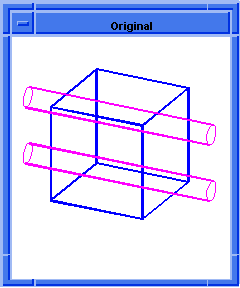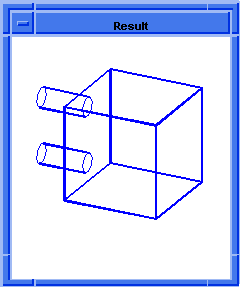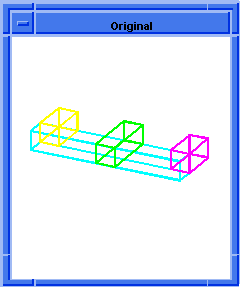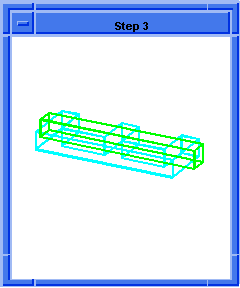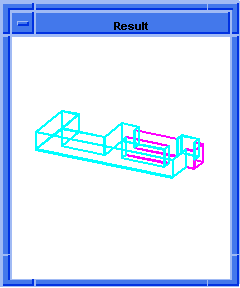Scheme Extensions |
|
|
|
Technical Article |
| Scheme is a public domain programming language, based on the LISP language,
that uses an interpreter to run commands. ACIS provides extensions (written
in C++) to the native Scheme language that can be used by an application
to interact with ACIS through its Scheme Interpreter. The C++ source files
for ACIS Scheme extensions are provided with the product. Spatial's Scheme
based demonstration application, Scheme ACIS Interface Driver Extension
(Scheme AIDE), also uses these Scheme extensions and the Scheme Interpreter.
|
bool:sel-unite
- Action
-
Unites two bodies.
Filename-
scm/scmext/sbool/selective_scm.cpp
APIs-
api_boolean,
api_selective_unite
Syntax-
(bool:sel-unite blank-body tool-body
option1 option2)
Arg Types-
Returns-
entity
Description
This scheme extension performs a union operation between two bodies.
The portions of bodies to keep is controlled by option1 and option2. The
blank body is returned and the tool body is deleted.
- Arguments
-
blank-body is an input entity.
-
tool-body is an input entity.
-
option1 controls the portions
of the body to be kept.
-
option2 controls the portions
of the body to be kept.
; bool:sel-unite
; Define a couple of solids and then do a
; selective boolean.
(define c1
(solid:cylinder
(position 0 0 -1)
(position 0 0 1) 5))
;; c1
(define c2
(solid:cylinder
(position 0 0 -1)
(position 0 0 1) 4.5))
;; c2
(define subtract (bool:subtract c1 c2))
;; subtract
(define b
(solid:block
(position -6 -6 -0.25)
(position 6 1 0.25)))
;; b
(define pnt (position 0 0 0))
;; pnt
(define unite (bool:sel-unite c1 b #t pnt))
;; unite |
[Top]
bool:select1
- Action
-
Creates a graph for the first stage of selective Booleans from a tool
body and a blank body.
Filename-
scm/scmext/sbool/selective_scm.cpp
APIs-
api_selective_boolean_stage1
Syntax-
(bool:select1 blank-body tool-body [acis-opts])
Arg Types-
Returns-
graph
Description
This Scheme extension creates a graph structure (for example, graph theory)
from the blank-body entity and the tool-body entity. Using Cellular Topology,
distinctive cells of the blank-body and the tool-body become vertices
of the graph. Overlapping portions of the cells become edges in the graph.
Once the graph has been created, further graph theory operations can be
performed to obtain a more desirable graph. This is then used as input
to the second stage of selective Booleans, bool:select2.
- Arguments
-
blank-body is an input entity.
-
tool-body is an input entity.
-
The optional acis-opts contains
parameters for versioning and journaling.
; bool:select1
; Create a blank body
(define blank (solid:block (position 0 0 0)
(position 25 10 10)))
;; blank
; blank => #[entity 2 1]
(define b2 (solid:block (position 5 0 0)
(position 10 5 10)))
;; b2
(define b3 (solid:block (position 15 0 0)
(position 20 5 10)))
;; b3
(define subtract (solid:subtract blank b2))
;; subtract
(define subtract2 (solid:subtract blank b3))
;; subtract2
; Create the tool body
(define tool (solid:cylinder
(position -5 2.5 5) (position 30 2.5 5)1))
;; tool
; Change the color of the tool for viewing.
(entity:set-color tool 3)
;; ()
; OUTPUT Original (define g (bool:select1 tool blank))
;; g
; OUTPUT Result
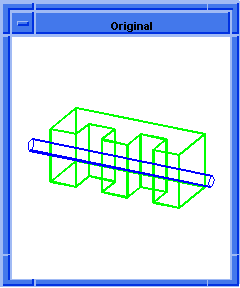  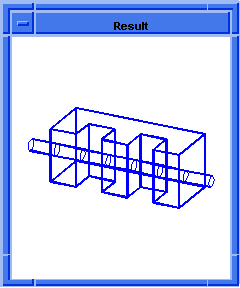
Figure. bool:select1 |
[Top]
bool:select2
- Action
-
Completes the selective Boolean process for the cells selected.
Filename-
scm/scmext/sbool/selective_scm.cpp
APIs-
api_selective_boolean_stage2
Syntax-
(bool:select2 in-body in-cells [acis-opts])
Arg Types-
Returns-
entity
Description
This extension modifies the in-body body based on either the results
of graph theory or a Cellular Topology cell list in in-cells. When in-cells
contains cell entities, these are the only entities that should be kept.
When in-cells is a graph, the graph could be the result of extensive graph
theory operations. However, the resulting graph still maps to cells in
the body and represents the cells to keep.
The mapping of cells in a graph to entities will not be the same from
execution to execution.
- Arguments
-
in-body is an input entity.
-
in-cells is an input entity
that contains either cell entities or a graph.
-
The optional acis-opts contains
parameters for versioning and journaling.
; bool:select2
; Create a selective boolean example.
(define blank (solid:block (position 0 0 0)
(position 25 10 10)))
;; blank
; blank => #[entity 2 1]
(define b2 (solid:block (position 5 0 0)
(position 10 5 10)))
;; b2
(define b3 (solid:block (position 15 0 0)
(position 20 5 10)))
;; b3
(define subtract (solid:subtract blank b2))
;; subtract
(define subtract2 (solid:subtract blank b3))
;; subtract2
(define tool (solid:cylinder
(position -5 2.5 5) (position 30 2.5 5)1))
;; tool
; Change the color of the tool for viewing.
(entity:set-color tool 3)
;; ()
(define g (bool:select1 blank tool))
;; g
; CAREFUL: The mapping of cell names to entities
; may not be the same each time this is run.
; Find the cells in the blank created by graph.
(define cells (entity:cells blank))
;; cells
; Put together list of things to keep.
; Leave out 2 and 6.
(define in-cells (list
(list-ref cells 0)
(list-ref cells 1)
(list-ref cells 3)
(list-ref cells 4)
(list-ref cells 5)
(list-ref cells 7)))
;; in-cells
; OUTPUT Original (define select (bool:select2 blank in-cells))
;; select
; OUTPUT Result
  
Figure. bool:select2 |
[Top]
bool:tube
- Action
-
Performs a selective Boolean operation, as specified in the given option.
Filename-
scm/scmext/sbool/selective_scm.cpp
APIs-
api_boolean_tube_body
Syntax-
(bool:tube blank tool start end opt [acis-opts])
Arg Types-
Returns-
entity
Description
The bool:tube performs a Boolean operation on the given blank and
tool bodies. The type of operation performed is specified by the opt of
type Tube-Options. The start and end regions for the operation can be
defined using positions or arrays of positions.
The purpose of this is to make selective Booleans more general so
they can be used by sweeping and other modeling operations.
The API api_boolean_tube_body,
which bool:tube uses, takes two bodies
(blank and tube) as input and calls the selective Booleans stage 1 once
and stage 2 the number_of_options times. Each time these selective Booleans
are called, this function automatically sets up the subgraph from a set
of options and start and end conditions.
Arguments
blank is an input body.
tool is an input body.
start gives the start region
for the operation in terms of position or array of positions.
end gives the end region for
the operation in terms of position or array of positions.
opt specifies the type
of operation performed.
The optional acis-opts contains
parameters for versioning and journaling.
[Top]
graph
- Action
- Creates a graph used in graph theory.
Filename- scm/scmext/sbool/selective_scm.cpp
APIs-
api_create_graph_from_cells,
api_create_graph_from_edges,
api_create_graph_from_faces,
api_pm_lookup_entity
Syntax-
(graph {graph-string | face-ent-list | cell-list}
[acis-opts])
Arg Types-
Returns-
graph
DescriptionThis extension creates a graph that can be used for graph theory operations
and selective Booleans. When creating a graph using a graph-string, the
entire string must be within double quotation marks. The vertex names
within the string can be any number of characters long without spaces
or dashes (-). Edges between vertices are indicated by a dash. The items
in the list of graph items within the string are separated by spaces.
When creating a graph using face-ent-list, the entities within the entity
list must be face entities. The face entities become vertices of the graph.
The ACIS topology is analyzed to determine which faces are connected.
The connections between faces become edges (or dashes) of the graph.
When creating a graph using cell-list, the list must contain cells from
Cellular Topology. The ACIS topology is analyzed to determine which cells
are connected. The connections between cells become edges (or dashes)
of the graph.
- Arguments
-
graph-string is an input string
that can be used for creating a graph.
-
face-ent-list is an input
entity that can be used for creating a graph.
-
cell-list is an input cell
that can be used for creating a graph.
-
The optional acis-opts contains
parameters for versioning and journaling.
; graph
; Create a simple example
(define g1 (graph "me-you us-them"))
;; g1
; Create an example using entities.
(define b1 (solid:block (position -5 -10 -20)
(position 5 10 15)))
;; b1
(define faces1 (entity:faces b1))
;; faces1
; Turn the block faces into vertices of the graph.
(define g3 (graph faces1))
;; g3 |
[Top]
graph:subgraph-2dcell
- Action
-
Returns a subgraph containing only the vertices that are 2D cells.
Filename-
scm/scmext/sbool/selective_scm.cpp
APIs-
api_subgraph_2dcell
Syntax-
(graph:subgraph-2dcell whole-graph [acis-opts])
Arg Types-
Returns-
graph
Arguments-
whole-graph is an input argument.
-
The optional acis-opts contains
parameters for versioning and journaling.
; graph:subgraph-2dcell
; Create entities
(define b1 (solid:block (position -40 0 0)
(position 40 10 10)))
;; b1
(define b2 (solid:block (position 30 -10 -10)
(position 45 20 20)))
;; b2
(define face1 (face:planar-disk (position -10 0 0)
(gvector 1 0 0) 20))
;; face1
(define sheet1 (sheet:face face1))
;; sheet1
(define sh2d-1 (sheet:2d sheet1))
;; sh2d-1
(define face2 (face:planar-disk (position -30 0 0)
(gvector 1 0 0) 20))
;; face2
(define sheet2 (sheet:face face2))
;; sheet2
(define sh2d-2 (sheet:2d sheet2))
;; sh2d-2
(define face3 (face:planar-disk (position -20 15 0)
(gvector 0 1 0) 30))
;; face3
(define sheet3 (sheet:face face3))
;; sheet3
(define sh2d-3 (sheet:2d sheet3))
;; sh2d-3
(define e (bool:nonreg-unite b1 b2 sh2d-1 sh2d-2
sh2d-3))
;; e
(define plane-pos (position -20 0 0))
;; plane-pos
(define plane-normal (gvector 1 0 0))
;; plane-normal
(define imprint-face (face:planar-disk
plane-pos plane-normal 50))
;; imprint-face
(define imprint-sheet (sheet:face imprint-face))
;; imprint-sheet
(define sh2d-4 (sheet:2d imprint-sheet))
;; sh2d-4
(define sol-im1 (solid:imprint e imprint-sheet))
;; sol-im1
(cell:attach e)
;; (#[entity 12 1] #[entity 13 1] #[entity 14 1]
;; #[entity 15 1] #[entity 16 1] #[entity 17 1]
;; #[entity 18 1] #[entity 19 1] #[entity 20 1]
;; #[entity 21 1])
(define g (graph (entity:cells e)))
;; g
(define g-2d (graph:subgraph-2dcell g))
;; g-2d
(define g-3d (graph:subgraph-3dcell g))
;; g-3d |
[Top]
graph:subgraph-3dcell
- Action
-
Returns a subgraph containing only the vertices that are 3D cells.
Filename-
scm/scmext/sbool/selective_scm.cpp
APIs-
api_subgraph_3dcell
Syntax-
(graph:subgraph-3dcell whole-graph [acis-opts])
Arg Types-
Returns-
graph
Arguments-
whole-graph is an input argument.
-
The optional acis-opts contains
parameters for versioning and journaling.
; graph:subgraph-3dcell
; Create entities
(define b1 (solid:block (position -40 0 0)
(position 40 10 10)))
;; b1
(define b2 (solid:block (position 30 -10 -10)
(position 45 20 20)))
;; b2
(define face1 (face:planar-disk (position -10 0 0)
(gvector 1 0 0) 20))
;; face1
(define sheet1 (sheet:face face1))
;; sheet1
(define sh2d-1 (sheet:2d sheet1))
;; sh2d-1
(define face2 (face:planar-disk (position -30 0 0)
(gvector 1 0 0) 20))
;; face2
(define sheet2 (sheet:face face2))
;; sheet2
(define sh2d-2 (sheet:2d sheet2))
;; sh2d-2
(define face3 (face:planar-disk (position -20 15 0)
(gvector 0 1 0) 30))
;; face3
(define sheet3 (sheet:face face3))
;; sheet3
(define sh2d-3 (sheet:2d sheet3))
;; sh2d-3
(define e (bool:nonreg-unite b1 b2 sh2d-1 sh2d-2
sh2d-3))
;; e
(define plane-pos (position -20 0 0))
;; plane-pos
(define plane-normal (gvector 1 0 0))
;; plane-normal
(define imprint-face (face:planar-disk
plane-pos plane-normal 50))
;; imprint-face
(define imprint-sheet (sheet:face imprint-face))
;; imprint-sheet
(define sh2d-4 (sheet:2d imprint-sheet))
;; sh2d-4
(define sol-im1 (solid:imprint e imprint-sheet))
;; sol-im1
(cell:attach e)
;; (#[entity 12 1] #[entity 13 1] #[entity 14 1]
;; #[entity 15 1] #[entity 16 1] #[entity 17 1]
;; #[entity 18 1] #[entity 19 1] #[entity 20 1]
;; #[entity 21 1])
(define g (graph (entity:cells e)))
;; g
(define g-2d (graph:subgraph-2dcell g))
;; g-2d
(define g-3d (graph:subgraph-3dcell g))
;; g-3d |
[Top]
graph:subset-with-plane
- Action
-
Finds the subset of a graph on one side of a plane.
Filename-
scm/scmext/sbool/selective_scm.cpp
APIs-
api_subset_graph_with_plane
Syntax-
(graph:subset-with-plane whole-graph plane-origin
plane-normal [acis-opts])
Arg Types-
Returns-
graph
Description
Finds the subset of a graph on one side of a plane. The graph must first
be split at that plane. It is assumed that the graph is made of entities
which are either faces or cells.
- Arguments
-
whole-graph is an input graph
that is split to get a subset of the graph.
-
plane-origin is the position
of the plane.
-
plane-normal is a vector to
the plane.
-
The optional acis-opts contains
parameters for versioning and journaling.
; graph:subset-with-plane
; Create entities
(define b1 (solid:block (position -40 0 0)
(position 40 10 10)))
;; b1
(define b2 (solid:block (position -40 10 0)
(position -30 30 10)))
;; b2
(define b3 (solid:block (position 30 10 0)
(position 40 30 10)))
;; b3
(define b4 (solid:block (position -5 0 0)
(position 5 30 10)))
;; b4
(define b5 (solid:block (position -35 15 0)
(position 35 25 10)))
;; b5
(define u1 (bool:unite b1 b2 b3))
;; u1
(define whole-entity (bool:nonreg-unite u1 b4 b5))
;; whole-entity
(cell:attach whole-entity)
;; (#[entity 7 1] #[entity 8 1] #[entity 9 1]
;; #[entity 10 1] #[entity 11 1] #[entity 12 1]
;; #[entity 13 1] #[entity 14 1] #[entity 15 1]
;; #[entity 16 1])
(define whole-graph (graph
(entity:cells whole-entity)))
;; whole-graph
(define plane-pos (position 5 0 0))
;; plane-pos
(define plane-normal1 (gvector 1 0 0))
;; plane-normal1
(define plane-normal2 (gvector:transform
plane-normal1 (transform:scaling -1)))
;; plane-normal2
(define partial-graph1 (graph:subset-with-plane
whole-graph plane-pos plane-normal1))
;; partial-graph1
(define partial-graph2 (graph:subset-with-plane
whole-graph plane-pos plane-normal2))
;; partial-graph2
; Make sure two halves have nothing in common.
(law:equal-test (graph:intersect
partial-graph1 partial-graph2) (graph ""))
;; #t
; Make sure two halves are both non-empty
(law:equal-test
(equal? partial-graph1 (graph "")) #f)
;; #t
(law:equal-test
(equal? partial-graph2 (graph "")) #f)
;; #t |
[Top]
tube:options
- Action
-
Creates a data structure used by selective Booleans.
Filename-
scm/scmext/sbool/selective_scm.cpp
APIs-
None
Syntax-
(tube:options [keep-law-string keep-law]
[keep-branches-string branch-bool]
[bool-type-string bool-type]
["connected" logical]
["merge" logical]
["only_from" integer])
Arg Types-
Returns-
entity
Description
The purpose of the Tube-Options data structure is to hold information
between selective Boolean operations stages 1 and 2 and to make selective
Booleans accessible by other modeling operations. Sweeping, among other
modeling operations, creates and uses this data structure. The data structure
is used as input to bool:tube.
- Arguments
-
The options are explained in detail in the discussion topic Options
for a Law Sweep and include:
-
- bool_type
-
- keep_branches
-
- keep_law
; tube:options
; Define some entities
(define b (solid:block (position 0 0 0)
(position 10 10 10)))
;; b
(define c1 (solid:cylinder (position -5 5 2)
(position 15 5 2)1))
;; c1
(define c2 (solid:cylinder (position -5 5 8)
(position 15 5 8)1))
;; c2
(define c (solid:unite c1 c2))
;; c
(define start (list (list-ref (entity:faces c) 1)
(list-ref (entity:faces c) 4)))
;; start
(define end (list (list-ref (entity:faces c) 2)
(list-ref (entity:faces c) 5)))
;; end
(define opt1 (tube:options "keep_law" "x=0"
"bool_type" "UNITE"))
;; opt1
(define tube (bool:tube b c start end opt1)))
;; tube ; Another Example.
(define b (solid:block (position 0 0 0)
(position 10 10 10)))
;; b
(define c (solid:cylinder (position -5 5 5)
(position 15 5 5)2))
;; c
(define start (list-ref (entity:faces c) 1))
;; start
(define end (list-ref (entity:faces c) 2))
;; end
(define opt1 (tube:options "keep_law"
"x=0" "bool_type" "unite"))
;; opt1
opt1
; #[Tube_Options "keep_law" X=0 "keep_branches"
#f"unite"]
(define d (bool:tube b c start end opt1))
;; d |
[Top]
© 1989-2007 Spatial Corp., a Dassault Systèmes company. All rights reserved.

![]()



